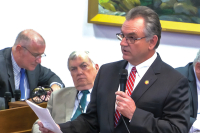Class Notes: The new reality for teachers
By Dawn Gilchrist-Young
I’m writing this because I teach three sections of senior English at Swain High School, where I’ve taught English in grades nine through 12 for almost 15 years. However, I can only say I’ve loved what I do for 14 of those years, and that’s because my first year in public education left me neither time nor energy to ponder the luxury of how I felt about my work. Having no time to reflect is typical for a first-year public school teacher.
Then, as now, for 35 weeks a year, I spent three to four hours on one weeknight each week and three or so hours each weekend responding to individual student writings, in addition to the regular two hours of grading and reading most evenings and three or four hours of planning each weekend. These hours were outside of what I did at school with teaching, committee meetings, mentoring responsibilities, professional development, and reading to keep up with advances and reversals in my profession. I put in this number of hours so that my students have the same benefit of direct personal attention, even in classes at Swain, that my 10 to 15 students per class had at the expensive boarding school where I first taught high school English. When I became the department chair at Swain — a leadership role I fell into by forfeit — I gave myself the goal of making my department one that could compete with any private school in the state. Because the state’s education budget allowed almost $9,000 per pupil expenditure per year, and because teacher pay was in the healthy middle of national rankings in those years and took into account aspects such as advanced degrees and cost of living, offering my students the best English teachers I could find was a real possibility. For education, the middle 2000s were a season of optimism coupled with hard work. Possibilities depended only on the teachers’ willingness to work for the students in whom we so believed and the students’ capacity to learn.
All of this is not to say, of course, that this year’s N.C. per pupil expenditure of a little more than $5,000, or the end of additional monies for advanced degrees or cost of living, or the embarrassment of being 46th to 48th (depending on your source) in national pay rankings, well, it is not to say all of this has made my department less effective. My teachers, by and large, knock themselves out to stay abreast of best teaching practices. My teachers, by and large, put in as many hours a week as I do in order to give our students what they need. My teachers, by and large, are the same champions of the last bastion of democracy that they were all those years ago when public schools were still considered a source of talent and hope for the country’s and the world’s future, and North Carolina’s governors and General Assemblies did not let an unconstitutional elitism dictate legislation.
The difference in that season and this is stark. The legislative climate in which public schools now struggle to survive demands of us all a dogged determination in the face of enormous bureaucratic disrespect, a willed hopefulness that we can get by until the legislative madness in Raleigh ends, and, I am very sorry to say, the donning of the martyr’s habit that has always been expected of a profession that is mostly women.
Related Items
If we want increased opportunities for our students, we cannot rely on legislation to help us. We now have only ourselves and the communities we create within our own ranks to fall back on, and the thinking among the best teachers I know is that what we do and those for whom we do it have no value to the ruling majority of representatives in Raleigh except, perhaps, to provide a shuffling supply of low-paid workers to remove garbage from our legislators’ homes, trim the roses on our legislators’ lawns, and clean the toilets in which our legislators have dropped them at 16 West Jones Street.
(Dawn Gilchrist-Young can be reached at This email address is being protected from spambots. You need JavaScript enabled to view it..)
FY 2013-2014
K: 1 teacher per 19 students
1-3: 1 teacher per 18 students
4-6: 1 teacher per 24 students
7-8: 1 teacher per 23 students
9: 1 teacher per 26.5 students
10-12: 1 teacher per 29 students
— from the NC 2013 Session Committee Report on Budget for Public Education
Private schools average 13 students per teacher, with over 35% of private schools having a student/teacher ratio lower than 10 to 1 (their emphasis).
— from the North Carolina Private Schools Blog
Private schools are not subject to oversight of their finances, curriculum, personnel qualifications, or testing and accountability measures that apply to all N.C. public schools. Under House Bill 944, private schools would receive taxpayer funding without public oversight or accountability.
— Kannapolis City Schools Newsletter, May, 2013
Adjusting for inflation, official figures from the North Carolina Department of Instruction show that annual per student spending has declined from $6,270 to $5,488.
— from the Transylvania Times, Sept. 16, 2013
Most other states held steady or saw small gains, including those neighboring North Carolina. In the 2013 rankings, North Carolina landed 46th on average teacher pay.
— from the Charlotte Observer, Aug. 17, 2013
Per capita money income in the last 12 months, 2007-2011 (2011 dollars) $19,506
— Fast Facts about Swain County









